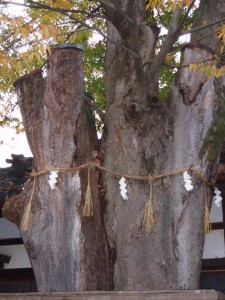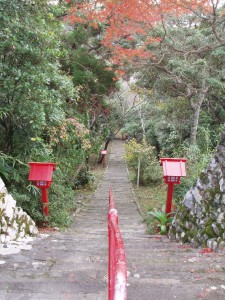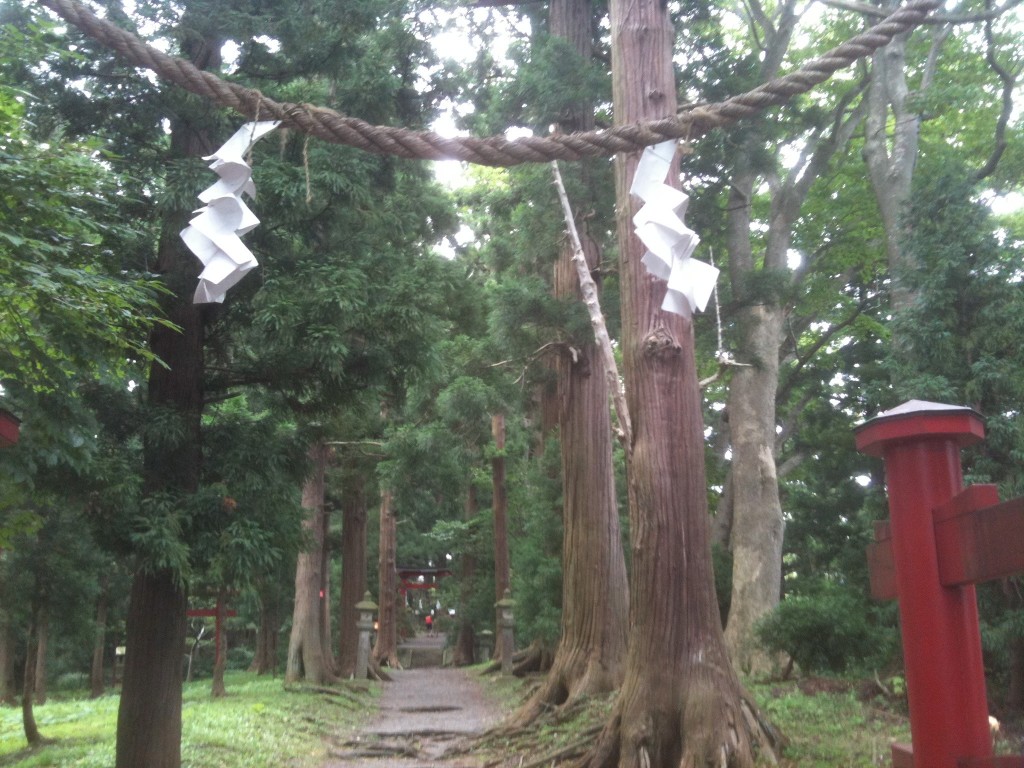Sacred groves are the closest contemporary Shinto comes to environmentalism. In an article in the Daily Yomiuri, naturalist Kevin Short writes of their history and the type of trees. For the full article, click here.
*********************************************************************************************

Sacred tree in a sacred grove
Last week, I spent several days cycling around the Hokuso countryside of northern Chiba Prefecture. I am currently working on a project to document many sacred groves that surround Shinto shrines and Buddhist temples in this region. At each site, I record the species and measure the circumference at chest height for all the big trees that form the grove.
In much of Japan, the sacred groves have been left uncut for close to 150 years. Over this period, many of the trees have grown to immense size, and in some cases the grove has developed into a small packet of primary forest. In western and southern Japan, including the south Kanto region, the original primary vegetation represented the extreme northern and eastern edge of the great Asian evergreen broad-leaved forests, a huge forest tradition distributed in a wide swath from the eastern Himalayas across China to the Pacific seaboard.
The area occupied by this forest type, called Joryoku Koyo Jurin or Shoyo Jurin in Japanese, centers on the subtropical and warm temperate zones. Normally, the main Japanese islands would be well outside this area. Thanks to the ameliorating effect of the Kuroshio and Tsushima warm currents, however, the trees extend northward along the coastline as far as Aomori and Iwate prefectures in the Tohoku region.

Ise Jinja, Tanegashima
Unfortunately, the areas formerly home to Japan’s evergreen broad-leaved forests were also the areas best suited to irrigated rice agriculture. This technology was introduced into northern Kyushu from the Korean Peninsula about 3,000 years ago, and rapidly spread eastward. As the population grew, the pressure on local forest resources increased, and much of the primary forest was cut down and replaced by faster-rejuvenating oak coppices or piney woods. In the more recent post-war years, almost all the remaining swaths of primary forest were clear-cut to make room for conifer timber plantations. Sacred groves thus now play an important ecological role by preserving small patches of this vital forest habitat.
Although my sacred grove survey is still in progress, the results clearly show that two species of tree in the Fagaceae or Beech Family (buna-ka) are dominant. These are the sudajii chinquapin (Castanopis sieboldii) and the aka-gashi evergreen oak (Quercus acuta). The most common circumferences for these sacred grove trees range from 150 centimeters to 250 centimeters, which may represent a typical size for 150-year-old trees. Some specimens, however, are obviously much older, with circumferences close to 400 centimeters.
Another charismatic sacred grove species, far rarer than the oaks and chinquapins but often rivaling them in stature, is the tabunoki bay tree. These trees are classified in the Lauraceae or Laurel Family (kusunoki-ka). They are resistant to salt air, which allows them to thrive along the immediate coastline. They are also fairly hardy, and as a result usually dominate sacred groves and other protected primary coastal forests in the far northern edge of the evergreen broad-leaved distribution.
During the winter, tabunoki can be identified by a large single bud that forms at the tip of each branch. In late April, these open up to let out the flowers and a new growth of leaves. The young leaves show a distinct reddish tint, and the flowers, although small and rather inconspicuous, are nectar-rich, and attract a varied insect clientele. The fruits are dark green at first, but ripen to a bluish people.

Uga Jinja at Nojiriko in Nagano

Leave a Reply